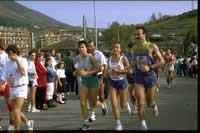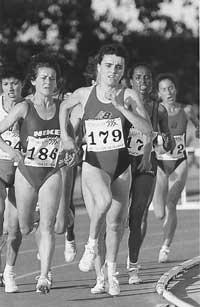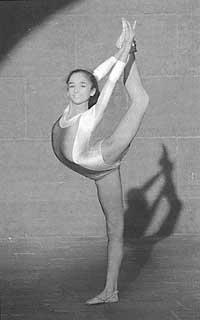Sport between injuries and health
1999/03/28 Kortabarria Olabarria, Beñardo - Elhuyar Zientzia

Amateur or Professional practitioner. The first person responsible for his health is the athlete himself. The phrase, even if it seems simple, has a profound importance: the athlete himself must try to do sports safely, leaving aside risk factors as much as possible during and when he is not.
If you choose to play sports on a daily basis and safely, minimum safety measures should be taken: avoid toxic habits such as alcohol and tobacco, strictly observe rest hours and take care of food.
Material and protection
Measures to deal with injuries that can be discarded through sports practice have a great importance the appropriate materials and protective measures. Ideally take all sports one by one and do a review, but since these pages do not have so much space, we can mention some basic things to consider when choosing the material. As for clothing, it is necessary to resort to fabrics that absorb sweat well and do not produce friction burns. The shoes should be of good adhesion to the ground and of protection against shocks, ensuring at the same time the flexibility of the joints and the stability of the body.
Protective materials cannot be forgotten in the prevention of sports injuries. There are protective materials for each sport, specially designed, approved and standardized. Its use in some competitions is legally established, but it is not regulated for training sessions. Otherwise, the athlete should act as if it was mandatory to use it in training, taking the necessary measures.
Training
From the point of view of sports medicine, to achieve the best results and ensure the good health of athletes, it is necessary to adopt a series of basic behaviors in training:
- Progressive loads so that the body gradually accepts the work it does. This will prevent overtraining problems and fatigue injuries.
- An adequate periodicity, that is, an active rest that allows the body to retake energy.
- Specialized training, adapted to the characteristics of each person, since we are not all able to face the same workloads. Also when it is customary to train in team.
- To guarantee the good health of the athlete it is necessary to take care of the general training in order to develop the general physical abilities of the athlete. In addition, each athlete must perform a special training adapted to the sport they practice.
- Work properly the technique, especially with young people, so that the body gets used to certain movements.
- Warm-up before sports sessions to ensure the development of all muscles and not just those who work in a certain sport.
- Work the psychological field so that the training is not what is done in the face of the competition, but is an instrument that can help in everyday life.
Sport and health
In addition, there are more aspects that can be taken into account for the prevention of injuries and health, such as sports facilities, medical equipment, etc., but those that most directly correspond to who wants to do sport would be the previous ones. We therefore know that safety measures must be taken before sports. But why sport? Is it good for health?
No doubt yes. To realize this it may be enough to look at the evolution of the human being. For thousands of years men were nomads and hunters, and later peasants, and daily activity was enough to work the body. In recent times, the decrease in physical activity in everyday life has been evident. Modern machines and transports have arrived at the service of man.
The physical form of those who live in industrial societies is increasingly precarious, since physical activity has almost disappeared from daily work. One of the direct consequences of the new way of life, in terms of health, has been the enormous increase in heart disease. The situation shows that sedentary life can be harmful to individuals and very costly to society.
However, studies do not indicate a direct relationship between physical activity and heart disease, while epidemiology shows that physical activity only has benefits, both to prevent mental illness and to the general state of people. Sport improves blood flow, adapts blood pressure, improves breathing, facilitates weight control and helps avoid other risks.
To have a good physical shape it is essential to practice sport regularly. It does not serve to take from time to time a great sports attraction and then stay a season without doing anything. Anyone with good physical form is well confronted with the physical challenges that may arise in everyday life, while the person with poor physical form -average tiredness - will not be able to cope with everyday tasks, which can cause the interruption of activity.
However, fitness and good health are not the same. They can be compatible but not the same. If one had to define good health, it would suffice to say absence of disease. Physical form, rather than good health, can be related to energy, to the challenge of facing the physical difficulties that may appear in life and of not physically depending on others.
When we listen to physical forms, therapies, etc., most of us directly associate with training sessions, sweat and healthy habits. This bond makes sense, as many understand it so, with violent daily training sessions. When speaking from a medical point of view - at least the International Federation of Sports Medicine sees it - the plan can be soft. According to the aforementioned entity, to obtain a suitable physical form it would be sufficient to perform an aerobic activity of 3 to 5 times per week, for at least half an hour and at least one hour: walking, running, swimming, cycling, paddling, skating or skiing. It also does not exclude group sports, but always with little intensity and slowness. So cheer up, it won't hurt you!
Published in 7

Gai honi buruzko eduki gehiago
Elhuyarrek garatutako teknologia





